Introduction
What Do Pigeons Like To Eat: Pigeons, those ubiquitous urban birds often seen perched on ledges or strolling nonchalantly through city parks, have long been a subject of fascination and sometimes even exasperation for city dwellers worldwide. With their distinctive cooing calls and distinctive feathered appearance, pigeons pets have carved out a niche in our urban ecosystems. Understanding the dietary preferences of pigeons is not only a matter of idle curiosity but also a key factor in managing their presence in our urban environments. Pigeons, often referred to as rock doves, are opportunistic feeders, which means they can adapt their diet to the food sources available in their surroundings.
There are certain foods that pigeons tend to favor, and gaining insight into their culinary inclinations can shed light on their behavior and on how to coexist with these avian neighbors. In pigeon dietary habits, we will delve into the natural diet of pigeons in the wild, their adaptability to urban environments, and the types of foods that they are commonly attracted to. Additionally, we will consider the implications of pigeon feeding in urban areas, including the potential benefits and challenges associated with providing food for these birds.
So, whether you’re a bird enthusiast curious about pigeon feeding habits, a city dweller looking for ways to manage pigeon populations, or simply someone who enjoys observing the avian life that surrounds us, this investigation into what pigeons like to eat will offer valuable insights into the world of these adaptable and often underappreciated city birds. From grains and seeds to scavenged leftovers, let’s embark on a journey to uncover the culinary preferences of our feathered neighbors, the pigeons.
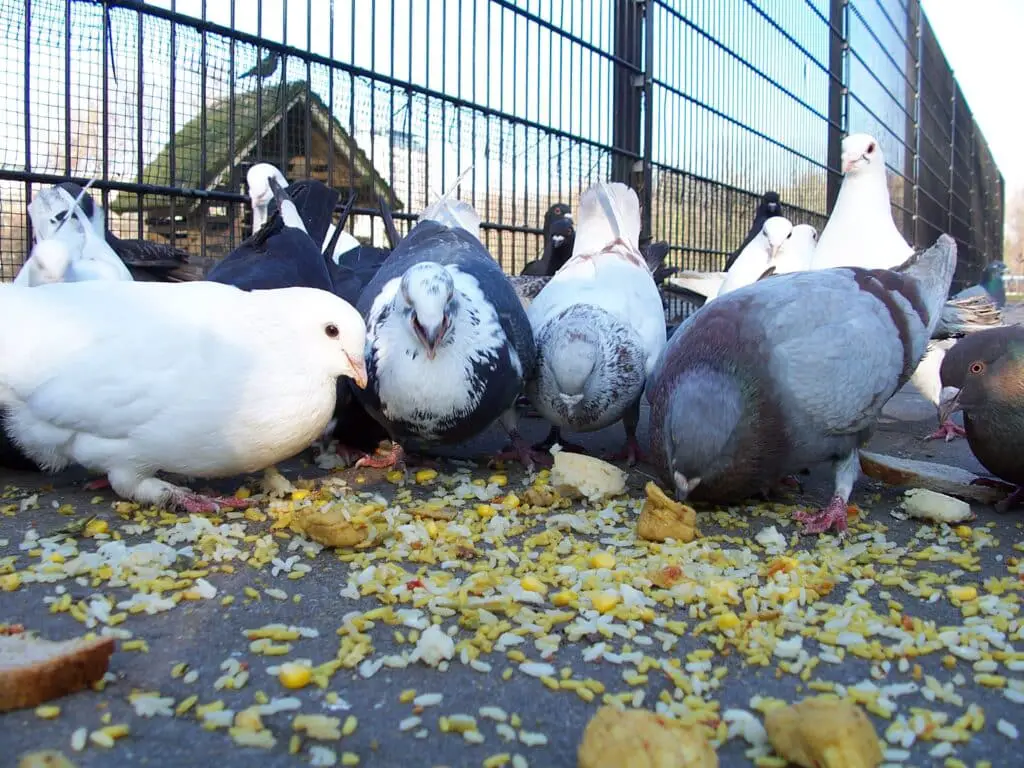
What can I feed a pigeon?
Pigeons eat grasses, leafy greens, berries, herbs, fruits, berries, grains, weeds, insects, and worms. It’s not a good idea to feed pigeons bread for many reasons. It’s best to set up a feeding box with appropriate options healthy for pigeons. Wild pigeons eat millet, cracked corn, sunflower seeds, and sorghum.
Seeds and Grains: Pigeons have a natural affinity for seeds and grains. A pigeon mix or birdseed that contains a variety of seeds like cracked corn, wheat, millet, and sunflower seeds. These foods are rich in essential nutrients and pigeons with the energy they need.
Pellets: Commercially available pigeon pellets or dove food are specially formulated to meet the dietary requirements of pigeons. These pellets are nutritionally balanced and all the essential vitamins and minerals.
Fresh Fruits and Vegetables: Pigeons enjoy a variety of fruits and vegetables. Offer them small portions of items like peas, corn, lettuce, spinach, grated carrots, and sliced apples. Ensure that fruits are ripe, and vegetables are fresh, clean, and free from pesticides.
Bread: While pigeons are often seen eating bread, it should be offered in moderation. Bread lacks essential nutrients and can lead to malnutrition if it becomes their primary food source. If you choose to feed bread, ensure it’s whole grain and only a small part of their diet.
Do pigeons eat rice?
Pigeons will eat almost anything, including rice. I don’t think rice (especially white rice) is especially nutritious as a bird food, but if the pigeons also eat a variety of other foods, they should be fine.
Cooked Rice: Pigeons can safely consume cooked rice. Cooked rice is soft, making it easier for them to digest. It’s essential to plain, unseasoned rice. Avoid adding any spices, sauces, or seasonings that might be harmful to birds.
Avoid Uncooked Rice Myths: There is a common misconception that uncooked rice can expand in a bird’s stomach, leading to health problems. However, this myth has been debunked by experts. Birds’ digestive systems are well-equipped to handle uncooked rice without any issues.
Balanced Diet: While rice can be a part of a pigeon’s diet, it should not be the sole or primary source of nutrition. Pigeons require a balanced diet that includes a variety of seeds, grains, fruits, and vegetables to meet their nutritional needs adequately.
Moderation: Like any other food, rice should be offered in moderation. Pigeons should have access to a variety of foods to ensure they receive a well-rounded diet. When feeding rice to pigeons, ensure that it is fresh and free from any contaminants. Spoiled rice can harm their health.
Can pigeons eat raw rice?
Fact is, rice cooked or uncooked won’t hurt wild birds at all. The rumor is that uncooked rice hits the bird’s tummy and then swells causing its stomach to explode. It’s simply not true. It’s not hot enough in a bird’s stomach to actually “cook” the rice.
Moderation: As with any food, it’s crucial to offer raw rice in moderation. Pigeons need a balanced diet that includes a variety of seeds, grains, fruits, and vegetables to meet their nutritional requirements.
Diversity in Diet: Pigeons benefit from a diverse diet. While raw rice can be a part of their food options, it should not be the sole or primary source of nutrition. Providing a mix of grains and seeds ensures that they receive a well-rounded diet.
Hydration: Raw rice is a dry food, so it’s pigeons with access to fresh water. Adequate hydration is crucial for their overall well-being. Feeding pigeons raw rice can be a simple and cost-effective way to supplement their diet, especially in urban environments where they may have limited access to natural food sources.
What are 3 things pigeons eat?
Pigeons have a broad diet in their natural environments, which includes seeds, grains, fruits, and insects. Depending on where they live, they might also eat leaves and flowers from plants. They are very flexible and can find food in many different places, which allows them to live in different environments.
Seeds and Grains: Pigeons have a strong affinity for seeds and grains, making up a significant portion of their natural diet. In the wild, they forage for various types of seeds and grains found on the ground and in fields. Pigeon-friendly seeds and grains include wheat, barley, corn, millet, sunflower seeds, and oats. These essential carbohydrates, proteins, and fats that are crucial for their energy and overall health.
Fruits and Vegetables: Pigeons are also known to consume a variety of fruits and vegetables. They enjoy foods like peas, corn, lettuce, spinach, grated carrots, and sliced apples. These items nutrients such as vitamins and minerals, contributing to a more balanced diet. However, to offer fresh and pesticide-free fruits and vegetables.
Bread and Food Scraps: In urban environments, pigeons frequently scavenge for food scraps, including bread. While bread is not the most nutritious option for pigeons and should be fed in moderation, it is a food source they readily accept. Feeding pigeons whole-grain bread is a better choice compared to processed white bread, as it offers slightly more nutritional value. Additionally, pigeons may consume food scraps left behind by humans, such as leftovers from picnics or outdoor dining.
Do pigeons eat dal?
When I was working in my living room, two pigeons flew into my balcony. They roamed here and there for a minute, perhaps searching for food. So, I thought of feeding them some chana dal (gram pulses) and rice grains. At first, they quickly ate chana dal, and then rice grains.
Dal as a Potential Food Source: Pigeons are attracted to grains and legumes, which are components of dal. If dal is spilled or left out in open areas where pigeons can access it, they may indeed eat it. Pigeons have a natural inclination to forage for seeds and grains, and lentils are similar in nature to the seeds and grains they often consume.
Moderation is Key: While pigeons can eat dal, it’s essential to it in moderation. Lentils are a rich source of protein and carbohydrates, which are beneficial for pigeons as part of a diverse diet. However, offering too much dal can lead to an imbalanced diet and potential health issues.
Hydration: Like all animals, pigeons require access to fresh water alongside their meals. Lentils, like many dry grains and legumes, are relatively low in moisture, so providing water is crucial to keep pigeons properly hydrated.
Balanced Diet: Pigeons, like humans, benefit from a balanced diet that includes a variety of foods. While dal can be part of their diet, it should not replace other essential components such as seeds, grains, fruits, and vegetables.
Do birds eat moong dal?
Moong beans are particularly beneficial for birds with respiratory problems. They help clear mucus from the respiratory tract and relieve congestion, making breathing easier for your bird.
Attraction to Legumes: Birds are naturally attracted to seeds, grains, and legumes, which are common components of their diets in the wild. Moong dal falls into this category, and its small size and shape make it appealing to many bird species.
Moderation: If you decide to offer moong dal to birds, it’s crucial to it in moderation. While moong dal is a good source of protein and carbohydrates, offering too much can lead to an imbalanced diet. A diverse diet that includes a variety of foods is essential for the health of birds.
Freshness and Cleanliness: Ensure that the moong dal you to birds is fresh and free from contaminants, such as mold or mildew. Spoiled legumes can be harmful to birds and may lead to health issues.
Hydration: Like all animals, birds need access to fresh water alongside their meals. Moong dal, like many dry legumes, has relatively low moisture content, so providing water is essential to keep birds properly hydrated.
Can pigeons eat chapati?
Pigeon eat grains. At home usually we have wheat , rice and chana which pigeons love to eat. If you don’t have any of the grain then you can make make small globules or capsules of ‘Roti’ (which are small enough for pigeons to pick from their beak) and then feed them.
Plain Chapati: If you choose to feed chapati to pigeons, it should be plain and unseasoned. Chapati made with basic ingredients like wheat flour and water is safe for pigeons to consume. Avoid offering chapati that contains spices, oils, or other additives, as these may not be suitable for their digestive system.
Moderation: As with any food, moderation is key. Chapati should be as part of a diverse diet and not as the sole or primary source of nutrition for pigeons. Pigeons benefit from a balanced diet that includes a variety of foods such as seeds, grains, fruits, and vegetables. Ensure that the chapati you offer to pigeons is fresh and free from contaminants. Stale or moldy chapati can be harmful to their health.
Hydration: Chapati is a dry food, so pigeons have access to fresh water alongside their meals. Adequate hydration is crucial for their overall well-being. When feeding pigeons or any wild birds, it’s essential to practice responsible feeding. Feeding in designated areas and avoiding excessive feeding can help manage the pigeon population and prevent overcrowding.
What do pigeons hate?
Pigeons dislike strong smells, like cinnamon and hot pepper. To deter pigeons from entering your garden, use cinnamon or peppermint essential oil or cayenne pepper mixed into a spray bottle of water. Spray the mixture anywhere you’ve noticed pigeon activity.
Loud Noises: Pigeons are sensitive to loud and sudden noises. Sounds like clapping, banging, or the blaring of horns can startle them and drive them away. This sensitivity to noise is one reason why scare tactics like sonic devices are sometimes used to deter pigeons from specific locations.
Predators: Pigeons are cautious birds and are naturally wary of predators. The presence of predatory birds, such as hawks, falcons, or owls, can make pigeons uneasy and cause them to flee the area. Some people use decoy predators or mimic bird-of-prey calls to discourage pigeons.
Unstable or Uncomfortable Surfaces: Pigeons prefer stable and comfortable perching surfaces. Surfaces that are uneven, slippery, or uncomfortable can discourage them from roosting or nesting in specific locations. Spiky or sloping surfaces on buildings are often installed to deter pigeons.
Strong Odors: Pigeons have a relatively keen sense of smell, and they dislike strong, pungent odors. Scents like mothballs, garlic, or commercial bird repellents can deter pigeons from an area. However, it’s essential to use these odors cautiously and follow safety.
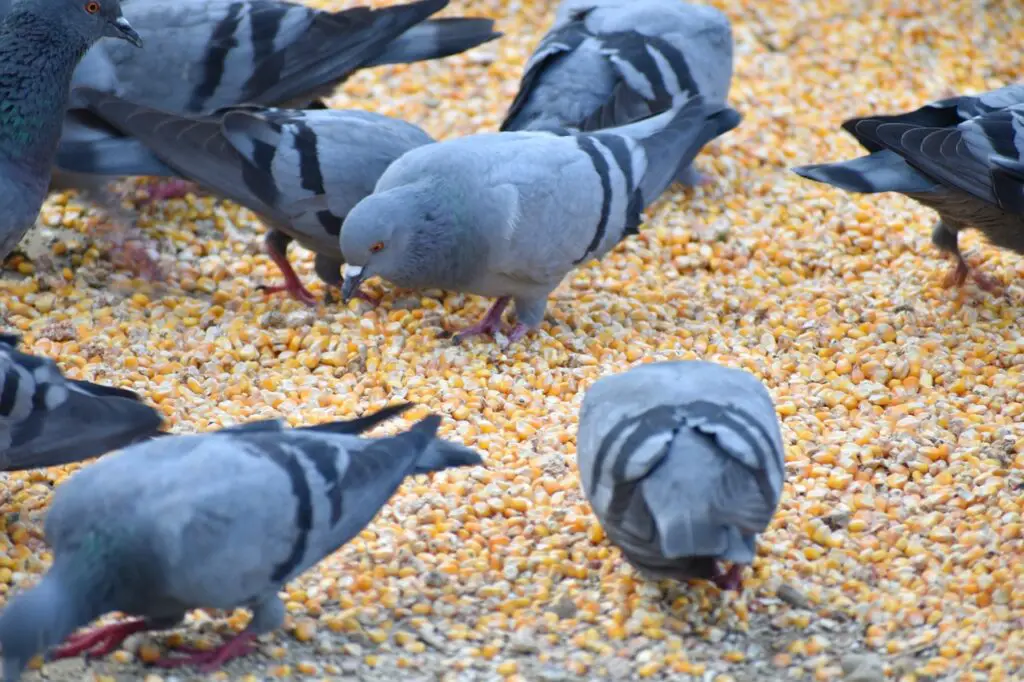
Conclusion
The dietary preferences of pigeons has revealed a fascinating dimension of these resilient and adaptable birds. Pigeons, also known as rock doves, have demonstrated their ability to thrive in urban environments by capitalizing on a wide range of available food pigeon sources. While their diet may vary based on their surroundings and the seasons, certain foods consistently pique their interest. In their natural habitat, pigeons primarily consume seeds, grains, and fruits. This natural diet reflects their adaptation to a life of foraging and scavenging in open landscapes.
As pigeons have become an integral part of urban ecosystems, their diet has expanded to include human foods. Urban pigeons often rely on handouts from well-intentioned humans. Bread crumbs, birdseed, and even bits of discarded fast food are commonly consumed by city pigeons. These readily available food sources can lead to both positive and negative consequences. On the positive side, food can help people connect with nature and appreciate the wildlife around them. It can also offer a lifeline for pigeons in harsh urban environments where natural food sources are limited.
Excessive feeding can lead to overcrowding, health problems, and increased pigeon populations, which may result in conflicts with humans and other wildlife. Therefore, it is essential for individuals and communities to strike a balance when it comes to feeding pigeons. Responsible and measured feeding, preferably with pigeon-friendly foods like grains and seeds, can help support these birds without causing harm. Moreover, understanding the nutritional needs of pigeons can aid in making informed decisions about their diet.

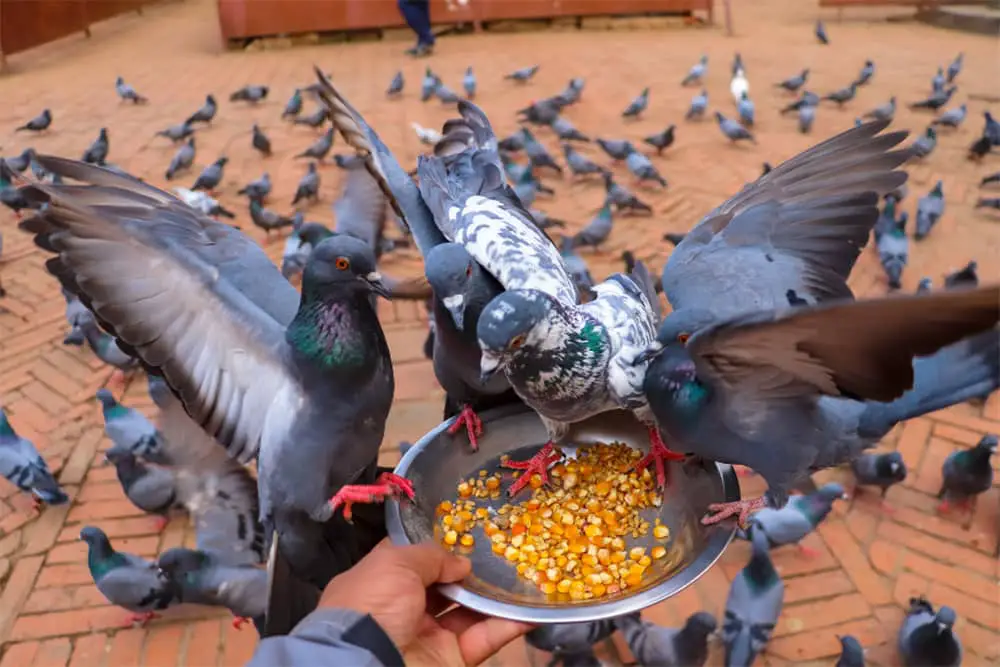
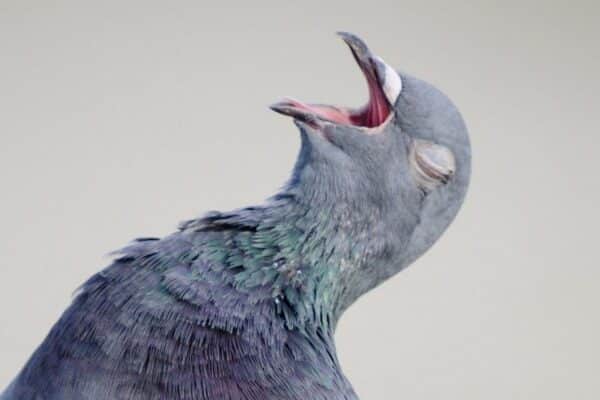
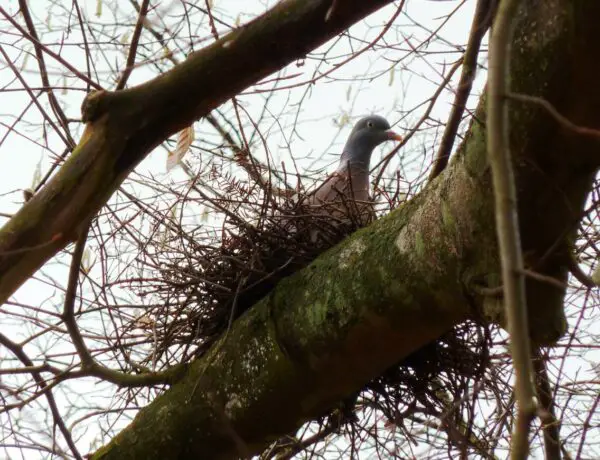
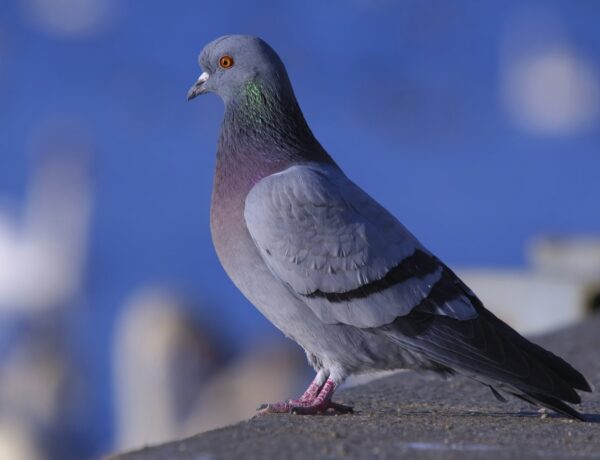
No Comments